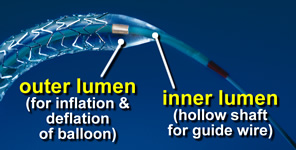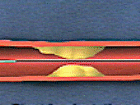|
In an effort to inform patients and healthcare
professionals about the issues associated with this latest development
in the world of drug-eluting stents, Angioplasty.org offers the
following report on the recent recall of the TAXUS™ Express2™ Paclitaxel-Eluting
Coronary Stent System and the Express2 Coronary Stent System. Patients
may also be interested in our article, "What's a Patient
To Do?".
Summary
- If you currently have a Taxus or Express2
stent implanted, you are not at risk and this recall does
not affect you
- 1.1 million of these stents (combined)
have been placed worldwide; there have been 95 confirmed
reports
of non-deflation problems, including 3 deaths and 43 serious
injuries
- The non-deflation problem is a mechanical
difficulty with the delivery system, not with the drug-eluting
stent itself
- The company has implemented an FDA-approved
modification to the manufacturing process to rectify this
problem
- The FDA recently finished their inspection
of both of Boston Scientific's manufacturing plants (in
Minnesota and Ireland) and found no problems
|
The Recall
On July 2, 2004, acting on reports of problems with balloon deflation
in the TAXUS™ Express2™ Paclitaxel-Eluting Coronary
Stent System (the company noted 30 complaints worldwide)
Boston Scientific identified a potential problem in
two manufacturing lots and recalled
200 of the stents. On
futher investigation and analysis, Boston Scientific identified
potential problems in additional lots of not only the Taxus Express2
Coronary Stent System but also the "bare metal" non-drug-coated
Express2 Coronary Stent System (the two systems share the same
delivery catheter). On July 16,
the company voluntarily
recalled approximately
85,000 TAXUS stent systems and approximately 11,000 Express2
stent systems, stating in its press release: "While
the number of customer reports of balloon deflation difficulty
is extremely
small, patient safety is the Company's paramount concern, and
therefore it has chosen to initiate this broader recall." On
August 5, the company recalled
an additional 3,000 Taxus stents, explaining
that these particular stents
were manufactured over a two-and-a-half-day period in late April
at its plant in Ireland, before any of the recalls occurred.
The
company
has
stated that
these
batches
should
have
been part
of the previous recall, but were not, due to a "an inspection
problem"
in its Galway plant -- an optical component of the new visual
inspection system (supplied by an outside vendor) was calibrated
three
thousandths of an inch off specification. While no problems had
surfaced from that batch, the company decided to recall all catheters
made
on those
days. Boston Scientific
has held meetings with the FDA, and the FDA
completed
inspection
of the
company's
manufacturing facilities in Maple Grove, Minnesota and Galway,
Ireland on September 8 -- no observations of problems were issued.
The
combined total for both stent systems of confirmed "no
deflation" complaints
(failure of the delivery catheter balloon to deflate within one
minute after deployment of the stent) was small -- 95 out of approximately
1.1 million implants worldwide. However,
as Boston Scientific noted, "impeded balloon deflation
can result in significant patient complications, including coronary
artery
bypass graft
surgery
and death". The
company received reports of one
death and 18 serious injuries associated with balloon deflation
for the TAXUS stent system,
and two deaths and 25 serious injuries associated with balloon
deflation in the Express2 (bare metal) stent system.
Background
The
TAXUS™ Express2™ Paclitaxel-Eluting Coronary Stent
System was approved
by the FDA on
March 4, 2004, making it the second drug-eluting stent available
in the U.S. (the first was the CYPHER, manufactured by
Johnson & Johnson / Cordis). Like all such devices, the TAXUS
stent had gone through a series of clinical trials to demonstrate
its
safety and effectiveness in preventing restenosis (reclosing of
the artery). Within a very short time, cardiologists had adopted
the new device and the TAXUS stent soon claimed
almost 70% of the
U.S market. Some doctors felt it was easier to use than the CYPHER
when trying to get into certain coronary arteries; it was
also more readily available in a wider range of sizes.
"No Deflation" Problem Isolated
Boston Scientific reports that the cause of the "no deflation" condition has
been isolated to the balloon catheter shaft and does not affect any other component
(the
stent,
drug or
polymer --
the coating that holds the drug on the stent). To understand the technical
issues involved, it is necessary to examine how stents are deployed.
 |
|
Stent-on-a-Balloon
Stents are placed in a process
similar to angioplasty. The
standard angioplasty catheter is a double-lumen
structure (a concentric
tube-within-a-larger-tube)
consisting of a balloon that is laser-welded to a hollow
shaft.
The hollow shaft lumen allows
the catheter to be passed over a guide wire, while the
outer lumen allows the balloon to be inflated and deflated.
Stents are manufactured and delivered
to the hospital already mounted on the balloon. |
In
the cath lab, the balloon/stent system is advanced by the
interventional cardiologist along a thin guide wire to
the diseased area
in the coronary artery. When the balloon is inflated,
the stent expands. The balloon is then deflated and withdrawn,
and the stent remains in place, serving as a permanent
scaffolding for the newly widened artery. Within
a few weeks, the natural lining of the artery, called
the endothelium, grows over the metallic
surface of the stent. This procedure is the same whether the
stent is the older "bare metal" type or the newer drug-eluting
type.
|
|
 |
 |
|
In the cases where
the Taxus stent balloon would not deflate, and could not
be withdrawn, Boston Scientific has reported that
the condition was caused by a narrowing, or "focal
neckdown",
of the outer inflation/deflation lumen which restricts the
flow
of contrast
media out of the
balloon. This seemed to center around the proximal balloon
weld, one of the two places where the balloon is laser-welded
to the catheter shaft. When the
shaft has a sufficient positive pulling force
exerted
on
it, as
would
occur when
withdrawing
the catheter, while the area towards the tip of the balloon
is constrained, a weakened area may collapse, thereby preventing
the balloon deflation.
|
The Solution
Boston
Scientific states that it has already implemented an FDA-approved
modification of the laser welding process to make the proximal
weld more robust, as well as an "enhanced
inspection method" by
quantitatively and visually inspecting every catheter to verify
the minimum outer diameter of the proximal balloon weld .
In
addition, its plant in Maple Grove, Minnesota was "piloting
a software program to monitor the parameters of the laser bonding
process", a program whose data allowed the company to identify
production lots with the appropriate laser bonds. The company states
that to date, noproblems have been reported with any of the stents
manufactured after these changes were put into place.
What Does This Mean for Patients and
Physicians?
As stated above, any patient who has already had a successful implant
does not need to be concerned -- the
problem was with deployment, not with the stent itself (for more
patient information on the
recall, read
Boston Scientific's Q&A's for patients
-- in PDF format).
On July 20, Boston Scientific
announced that
it had completed its recall and, according to Paul LaViolette,
head of the company's cardiovascular unit, it planned to ship
30,000 of the Taxus heart devices to its clients in the United
States
immediately and that all inventory in the
United States should be replaced by early August. He also stated
that none of the recalled stent systems will be redistributed anywhere
in the world. The most recent August 5 voluntary recall was an
expansion of the July 16 action. The company believes it has isolated
the problem and put into place new procedures that have eliminated
it.
Complications with new products are not infrequent.
Issues sometimes surface when a new device goes into widespread
use. For example, not long after the Johnson & Johnson / Cordis
CYPHER stent was approved last year by the FDA, some issues
regarding sub-acute thrombosis with the CYPHER were
raised
(read our
editorial on the CYPHER). Out of 450,000 CYPHER stents
implanted, 60 cases of sub-acute thrombosis resulting in patient
deaths had occurred (while the number was well within the complication
rate for bare metal stents, it still was considered cause
for concern -- subsequent investigation found no problem with the
device itself).
As for Boston Scientific, the impact will be
be financial, certainly in the short-term. When a product
is introduced so successfuly, and then hits a snag, it's a difficult
situation. And while the number of actual reported problems was
relatively small, the recall ultimately had to be relatively large.
As Jim Tobin, CEO of Boston Scientific, commented to theHeart.org, "If
you can't find a needle in a haystack, you have to recall the whole
haystack." Whether the cardiology
community, which had enthusiastically
embraced
the
Taxus
stent for the past four months, will continue to utilize this new
device as much as it has...well, in the words of Adam Feuerstein
of TheStreet.com, "Boston
Scientific Needs to Win Doctors' Hearts". This
may be happening. One month after the final recall, the company
reports that usage of the Taxus stent is almost at pre-recall levels.
As for patient perceptions and concerns about the stent, read our
feature topic, "What's a Patient To Do?".
For the latest
news about developments in the field, go to our Drug-Eluting
Stent NewsCenter. We welcome your
comments on this article.
Source: Angioplasty.org, July 20, 2004, updated
August 9, 2004
CONTACT: Burt
Cohen, Producer of Angioplasty.org
|

